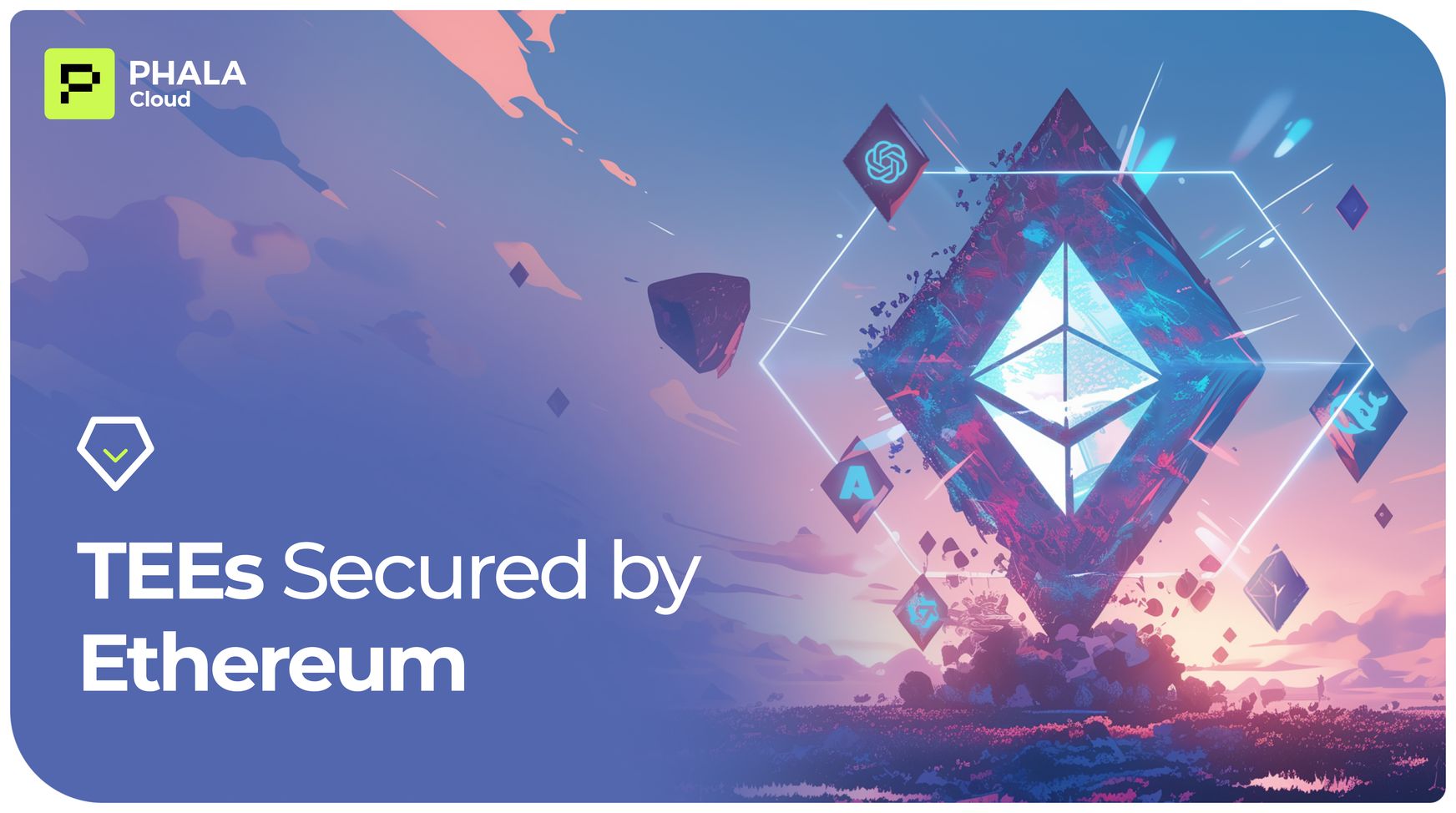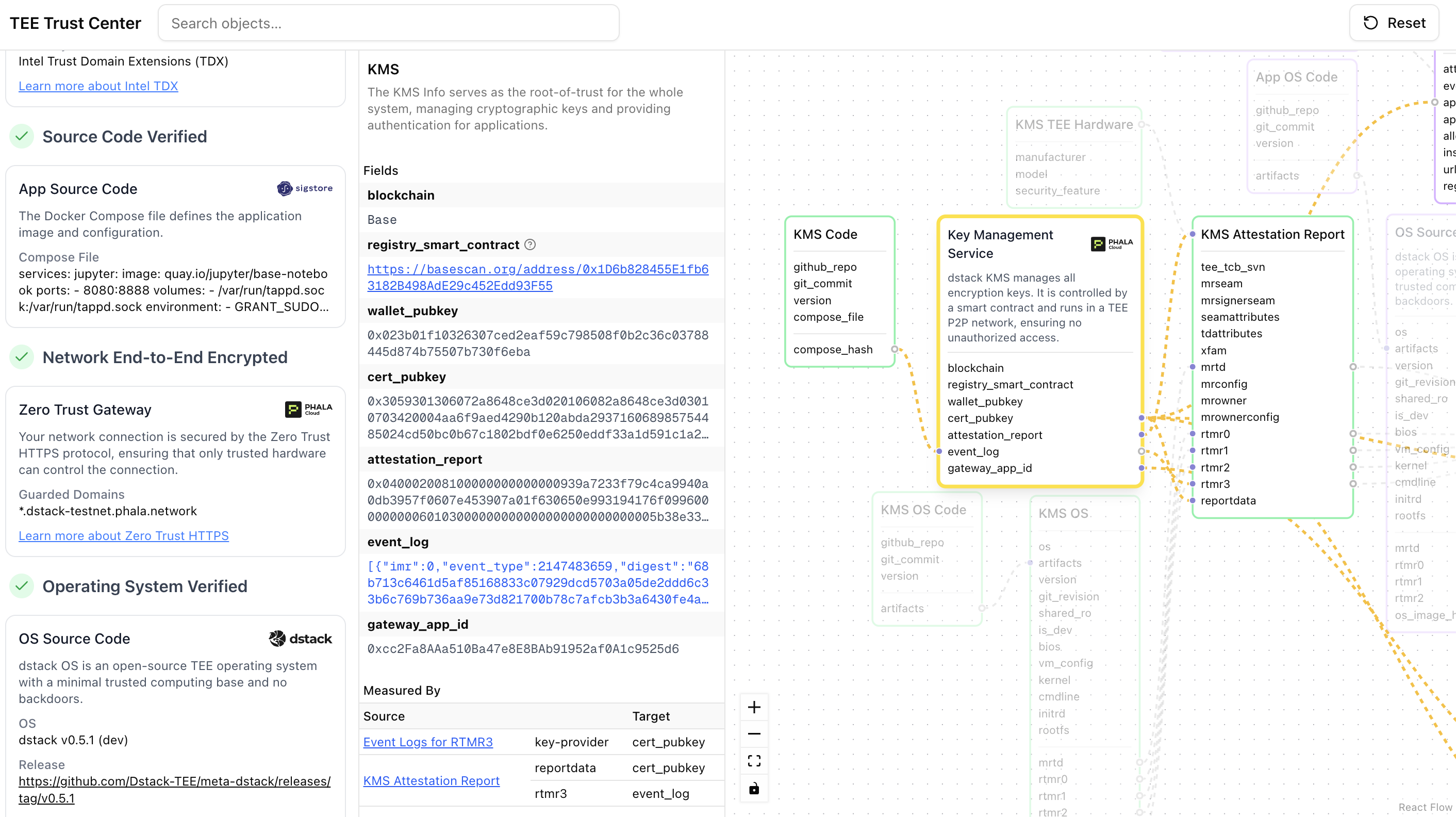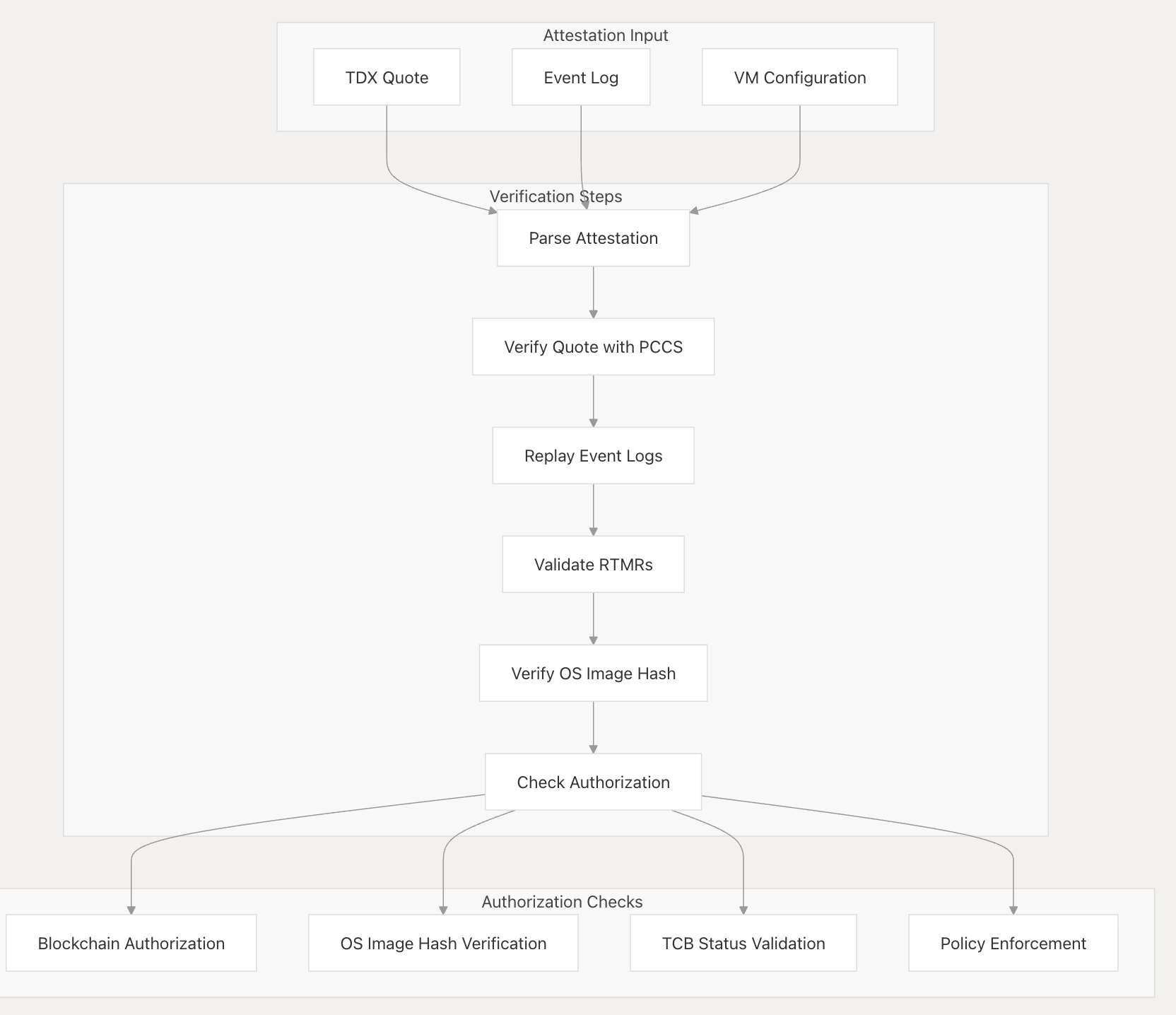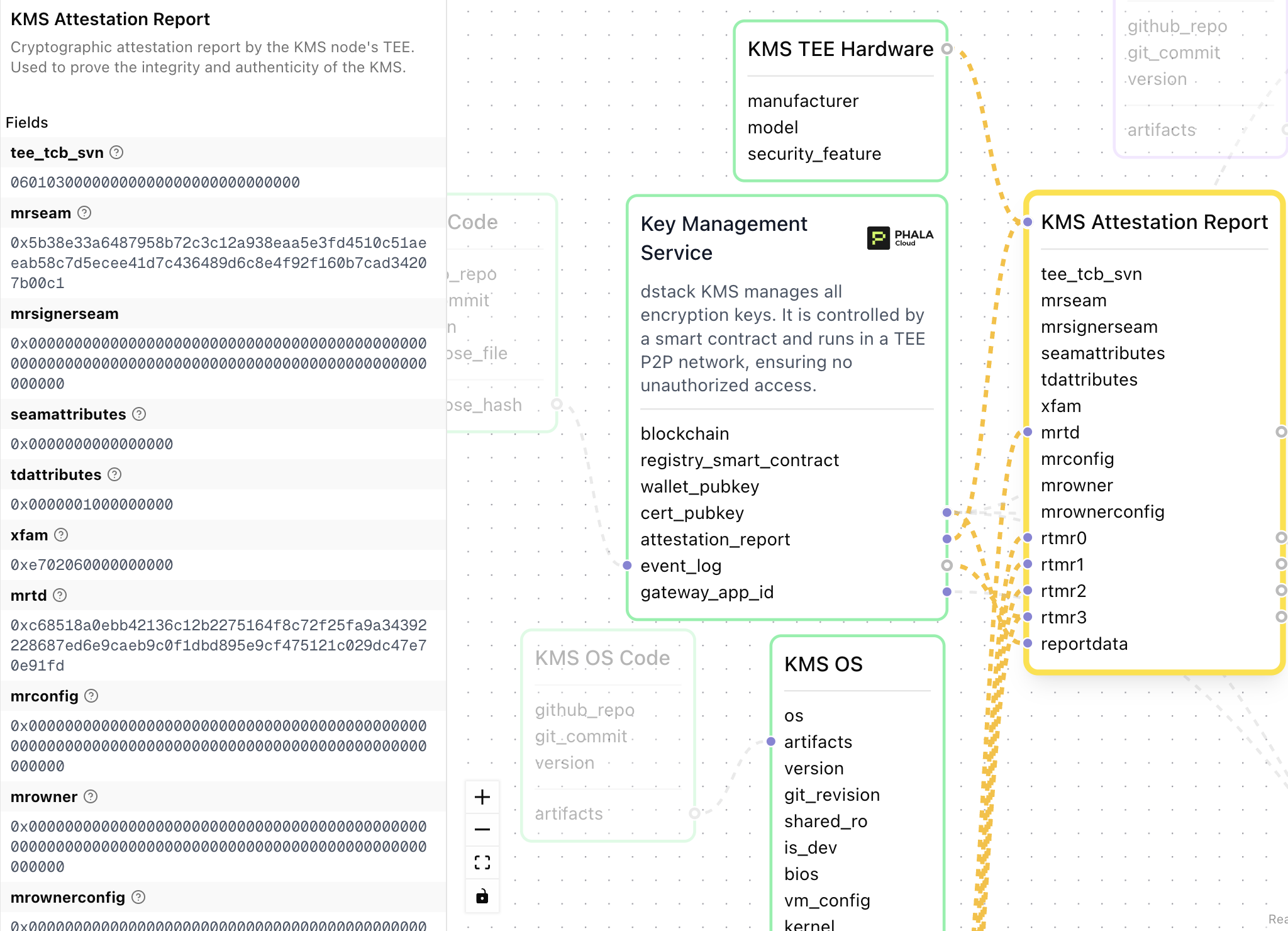
1. How TEEs Work — and Their Limits
A Trusted Execution Environment (TEE) is basically a secure box inside a processor. You load code into it, the CPU measures the code, and the box runs in isolation. Even if the host OS or hypervisor is compromised, data inside stays encrypted and code can’t be modified. Remote attestation adds the ability to prove to someone else what code is running.
That sounds solid, but anyone who has deployed TEEs in production knows the weak spots:
- Vendor monopoly on trust: Attestation roots are tied to Intel, AMD, or NVIDIA. If their infrastructure fails or is compromised, every system built on it inherits the risk.
- Opaque verification: Attestation evidence usually flows through vendor services. As a developer, you’re left trusting a third-party API rather than being able to verify the chain yourself.
- Operational pain: Migrating enclaves, reproducing builds, or revoking compromised instances is messy. TEEs alone don’t give you lifecycle management — you need glue code and governance wrapped around them.
In short, TEEs protect against local attacks but don’t address system-level trust. For multi-party AI workflows, relying on a single vendor’s root of trust isn’t acceptable.
2. Onchain KMS: Putting Ethereum in the Loop

Dstack’s approach augments TEEs with Ethereum, effectively moving the root of trust from sole hardware into the blockchain realm. In a traditional TEE setup, the “rules of the enclave” (which code can run, who can access data) are enforced by hardware and whoever deploys the enclave. With TEE secured by Ethereum, those rules are also enforced by smart contracts on Ethereum, creating a verifiable chain-of-trust that’s transparent and governed collectively rather than by a single provider. It’s like appointing an impartial public notary (the blockchain) to oversee the locked vault’s usage, rather than relying on the vault’s manufacturer alone.
How does this work in practice? The centerpiece is a Decentralized Root of Trust (DeRoT) – essentially an on-chain program that manages cryptographic keys and policies for the TEEs. In Dstack’s design, the hardware’s built-in key is no longer the sole authority. Instead, a smart contract (running on Ethereum or an EVM-compatible chain) defines which enclave code is considered valid and under what conditions it can operate.
When a TEE node wants to start an application, it must present its remote attestation to this on-chain contract (or a service governed by it). Only if the attestation’s measurements (code hash, etc.) match the pre-approved values in the contract will the system proceed to grant that enclave the secrets it needs to do useful work. In effect, the enclave has to “ask permission” from Ethereum before it can access sensitive data or keys. If the code isn’t what it’s supposed to be, permission is denied – no secrets, no service.

Here’s the flow:
- The KMS holds a master RootKey in its own enclave.
- An application enclave spins up, produces an attestation, and presents it to the KMS.
- The attestation is checked against Ethereum smart contracts, which record which code hashes and enclave configurations are considered valid.
- If the check passes, the KMS derives a unique key for the enclave and sends it in over a secure channel.
- Every key issuance or revocation is tied to an onchain event, so the lifecycle is publicly auditable.
This gives you:
- Deterministic key derivation (no secret state to manage).
- Reproducibility (an enclave can migrate and re-derive the same key).
- Governance hooks (if an enclave hash changes, the contract must be updated on-chain first).

Ethereum becomes the arbiter. The enclave isn’t trusted just because Intel or AMD said so — it’s trusted because the attestation aligns with a policy visible to everyone. In essence, integrating Ethereum with TEEs transforms the trust model from “trust the hardware and the cloud operator” to “trust code and math”. It leverages the blockchain’s neutrality and transparency to oversee how enclaves start and how keys are distributed. This is the philosophical shift from traditional security to web3 level security: “Don’t trust, verify.” Next, let’s look specifically at the key management piece of this puzzle – how secrets are generated and handed out in Dstack’s system, and how Ethereum secures that process.
3. Why Anchoring in Ethereum Matters
All of these interactions are audited by Ethereum. Every time a key is issued or rotated, a log (event) can be emitted on-chain. Each enclave’s public keys or fingerprints might be registered on-chain as well, so anyone can verify that a given output or signature indeed came from an enclave holding a legitimate key from the KMS. Essentially, code and cryptography become the new “admins”– there are no human administrators in some secret back room with access to the master keys. As the Dstack team puts it, admins are obsolete; code is sovereign. The smart contract and the KMS enclave code form a dual lock: both the blockchain governance and the hardware attestation must agree before a secret is unlocked.
Anchoring TEEs to Ethereum closes the loop in three ways:
- Verifiability: Enclave outputs can be signed and checked against public keys rooted in onchain policy. This lets downstream systems confirm that results really came from the right code.
- Governance: Updates, rotations, or policy changes are all on-chain transactions. No opaque operator actions, no silent reconfigurations.
- Revocation: If hardware or software is compromised, keys can be rotated or issuance stopped, and that decision is visible and enforceable.
All together, this workflow means you get the best of both worlds. The AI computation is as private as running in your own locked hardware, yet as transparent and verifiable as a smart contract. For users, it builds confidence that they can trust AI outputs without sacrificing their data privacy. For developers and companies, it enables new applications where sensitive data or proprietary models can be used in the cloud without fear of leakage, all while providing assurance to their users or stakeholders that everything is above board.
To cement the idea, let’s use a quick metaphor. Picture a sealed cooking pot (the TEE) supervised by a cooking show judge (Ethereum). Inside the sealed pot, a secret recipe is being executed on secret ingredients – no one can look in, preserving the chef’s IP and the ingredient privacy. But the judge has the recipe book and rules in hand (the on-chain policy) and a camera on the pot’s seals (remote attestation). If anything about the pot or recipe is off, the judge won’t allow the cooking to start (no keys given). When the dish is done, the pot serves it with a note signed by the judge and chef together (attestation of output), so the audience knows it’s authentic. Thus, we achieve a trustworthy dish without ever revealing the secret recipe or ingredients. This balance of secrecy and trust is what TEE secured by Ethereum achieves for AI computations.
4. Practices in the Field
This isn’t abstract. Here are some practical uses I’ve seen or prototyped:
- LLM inference with provenance: Each response is signed by the enclave. A client can verify the signature and know the model hash that produced it.
- Cross-organization analytics: Multiple firms load encrypted data into a shared enclave. Ethereum governance ensures only approved code runs, so no one worries about silent backdoors.
- Autonomous agents with guardrails: DAOs can run bots that hold private keys inside enclaves. Their behavior is bounded by code hash policies — if the bot logic changes, the DAO has to approve it on-chain.
- Zero-knowledge style serving: Model owners keep weights encrypted, clients keep inputs encrypted. Only the enclave ever sees them in the clear, and only for the duration of the computation.
What all of these share: you can deploy AI without asking users to take your word for it, and without sacrificing confidentiality.
5. How This Compares to Other Approaches
It’s worth comparing Dstack’s approach to other TEE-based platforms and security tools to understand the differentiators:
| Approach | Strengths | Weaknesses | TEE+Ethereum Edge |
| Cloud TEEs (AWS Nitro, Azure CVMs) | Isolation, cloud integration | Centralized attestation & KMS | Onchain policy & auditability |
| Web3 TEE Chains (Secret, Oasis) | Confidential contracts, native blockchain use | New languages, closed ecosystems | Standard containers + Ethereum governance |
| Bare SDKs (SGX SDK, Open Enclave) | Flexibility, open-source | DIY key mgmt & revocation | Built-in onchain KMS + lifecycle |
| Crypto-only (MPC, ZK) | Strong math guarantees | Too slow for AI, limited scope | Near-native performance + verifiability |
| TEE+Ethereum (Dstack) | Confidential + auditable, decentralized control | Relies on hardware security, governance design | Combines speed, privacy & trustless proof |
- Versus Traditional Cloud Enclaves (AWS Nitro, Azure Confidential VMs, etc.): Major cloud providers now offer confidential computing instances, but those typically keep the trust model within the provider’s boundary. For example, AWS Nitro Enclaves ensure isolation, but a user still relies on AWS’s attestation service and key management – essentially trusting AWS’s infrastructure to be honest and secure. In contrast, Dstack externalizes that trust to Ethereum. The attestation can be verified by anyone via an on-chain registry (no need to trust a single cloud’s attest server), and keys are managed by a smart contract rather than a closed AWS KMS. This yields greater independence and auditability. As one metric, consider compliance visibility: Phala (Dstack’s cloud) publishes attestation proofs on-chain for public verification, whereas a typical cloud might only provide private attestation logs or dashboardsphala.network. The mutual distrust design of Dstack treats even the cloud operator as untrustedphala.network, which is a stricter model than what Azure/AWS assume. In summary, while Nitro or Confidential VMs give you a black box, Dstack gives you a verifiable glass box – you can see (cryptographically) what’s inside the box without exposing the contents.
- Versus Other Web3 TEE Networks (Secret Network, Oasis, Phala’s own chain): Some blockchain projects have built their own confidential smart contract platforms (e.g. Secret Network on Cosmos uses TEEs to run private contracts). Dstack’s distinction is that it is chain-agnostic and developer-friendly. Rather than requiring you to write your logic in a new smart contract language to run in enclaves, Dstack lets you deploy standard Linux containers and binaries into enclavesgithub.com. This lowers the barrier to entry – you can bring existing AI models or microservices into a TEE without rewrite. Moreover, by using Ethereum as the anchor, Dstack leverages the robust security and ecosystem of the most battle-tested smart contract platform. Many earlier TEE networks used their own custom blockchain for coordination; using Ethereum means inheriting its security (billions in economic security) and its interoperability. Any Ethereum dApp can technically trigger or verify a Dstack enclave execution. Additionally, Dstack’s on-chain governance model is very flexible – it isn’t just hardcoded into one network’s protocol, but can be customized (even upgraded) by smart contracts. This makes it easier to integrate with enterprise governance (you could imagine a private Ethereum network or layer-2 governing a set of enclaves for a consortium). Finally, Dstack being open-source and audited sets it apart from some proprietary solutions – there’s transparency at the implementation level toophala.network.
- Versus Open-Source Enclave Frameworks (Graphene, Open Enclave, Intel SGX SDK): Developers could attempt to build something like this from scratch using available SDKs, but it would be a massive undertaking. Running code in an enclave is one piece; building a secure key management and attestation verification system around it is another. Dstack essentially provides a ready-made “TEE + blockchain middleware”. For example, the heavy lifting of secure boot, measuring all components, and establishing a chain-of-trust from BIOS to application is built-inphala.network. The framework measures the bootloader, OS, and container, and will detect any changes (altered hashes) before releasing secretsphala.network. Achieving that on your own with generic tools would require deep security expertise. Moreover, Dstack’s approach has been vetted by external security experts (the first comprehensive OS-level TEE platform auditphala.networkphala.network). In short, while one could use enclave SDKs to manually create a secure service, Dstack gives a higher-level, developer-friendly abstraction and confidence from its audit and community use. It’s the difference between building your own cryptosystem versus using a well-reviewed library – the latter is generally safer and more efficient.
- Versus Pure Cryptographic Approaches (MPC/Zero-Knowledge Proofs): It’s worth noting, for completeness, that privacy and verifiability can also be approached with pure math – multi-party computation, homomorphic encryption, zero-knowledge proofs, etc. Those techniques, however, often come at high computational cost or with limitations on supported logic. TEEs provide a general-purpose, efficient solution (near-native speed) by relying on hardware rather than heavy-duty cryptography. Dstack’s model can also incorporate these techniques where needed (for instance, they mention potentially using threshold cryptography within the KMSdocs.phala.network), but the main point is it achieves similar goals (privacy + correctness) in a more straightforward way for general workloads. The trade-off is that one has to trust the hardware – which is exactly why adding Ethereum’s checks and balances is so valuable. It mitigates the primary trust concern in TEEs (hardware or operator misbehavior) by adding independent verification and control. In combination, TEEs and blockchain create a solution that neither could easily accomplish alone: confidential, high-performance compute with global trust guarantees.
In summary, Dstack’s Ethereum-secured TEE architecture stands out by removing centralized trust points and offering a full-stack solution (from hardware attestation up to on-chain governance). It’s a “no compromises” approach – achieving confidentiality without forsaking transparency or vice versa. Other solutions might give you one or the other, or require deeper trust in a vendor. Dstack minimizes those trade-offs, which is why it represents a notable evolution in confidential computing for the web3 era
The distinction is subtle but important: TEEs keep data secret, Ethereum makes that secrecy provable and accountable.
Closing Thoughts
As someone who’s worked with enclave systems, I see this as the missing piece. TEEs alone give you a secure box, but you still have to trust whoever hands out the keys. By tying key distribution to Ethereum, you externalize that trust to a system designed for transparency and consensus.
It doesn’t remove every problem — you’re still exposed to hardware-level flaws, and governance design is its own challenge — but it pushes confidential AI from “just trust me” into “here’s the proof.”
For AI and Web3 developers, that shift matters. It’s how you get systems that are both private enough for sensitive data and open enough to be trusted across organizational boundaries.